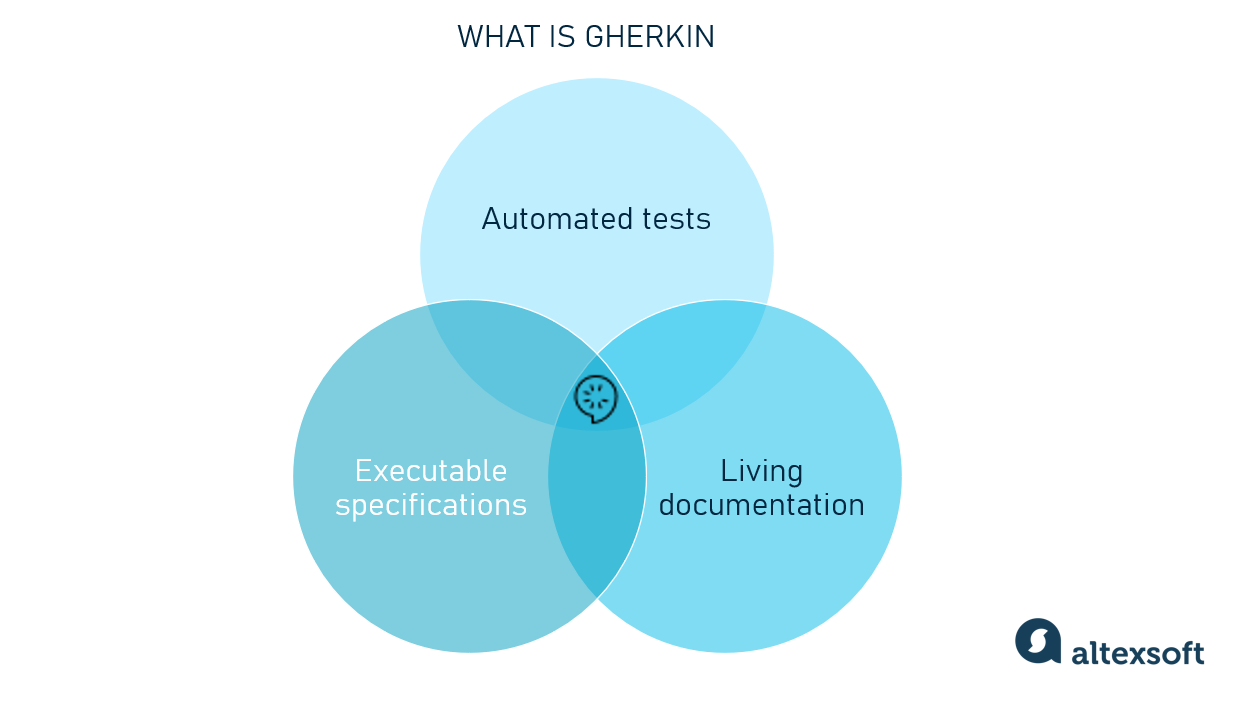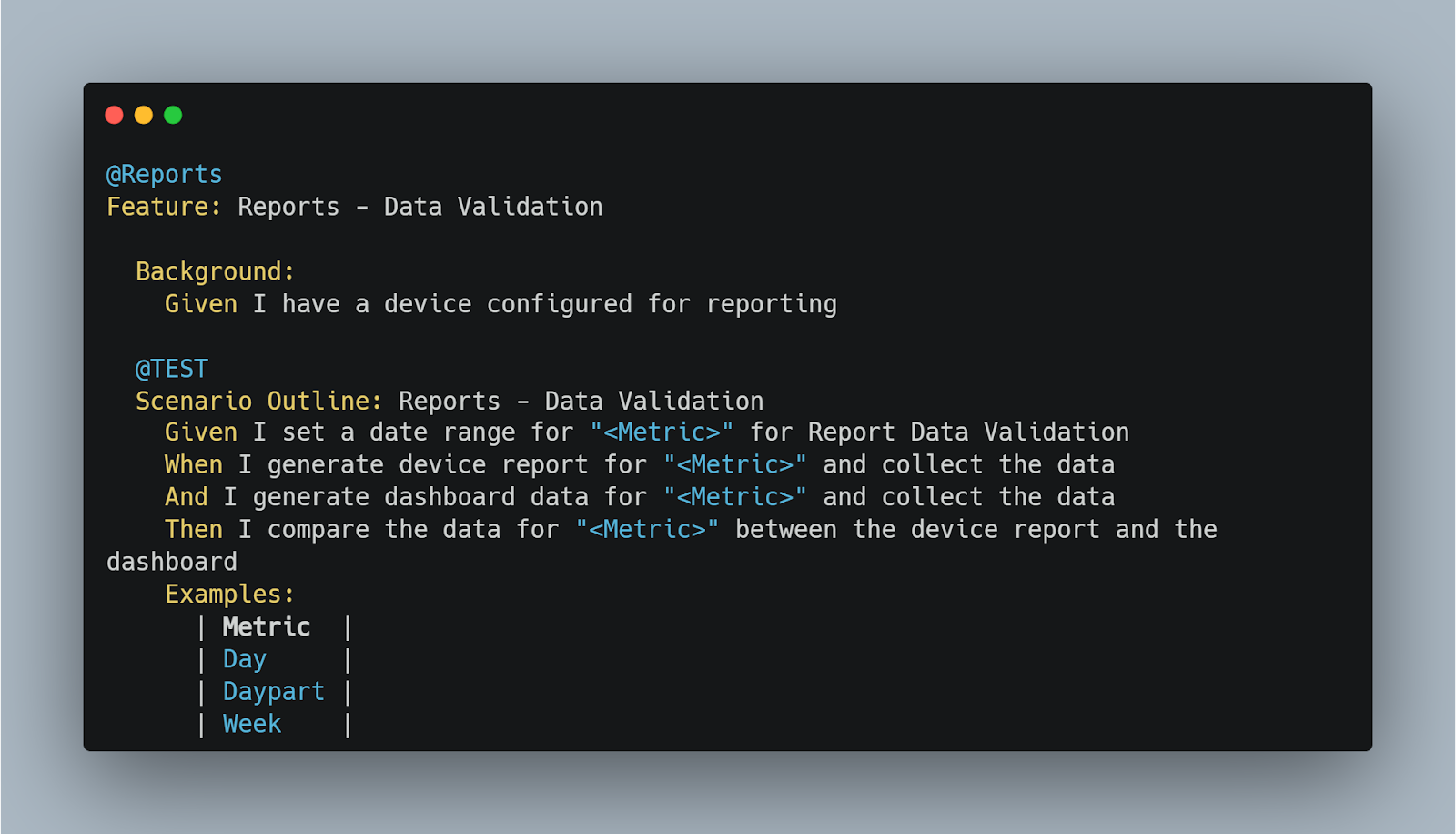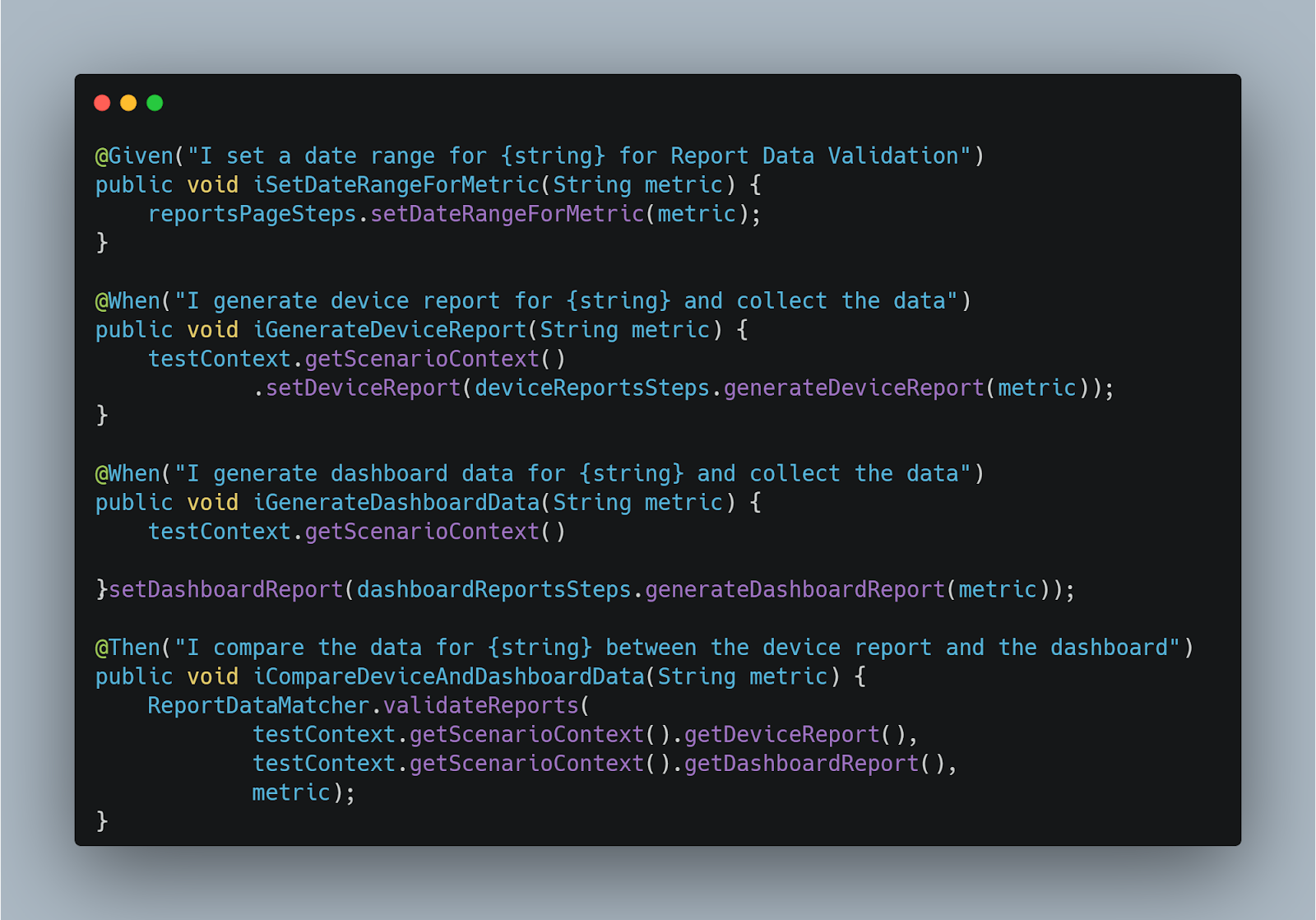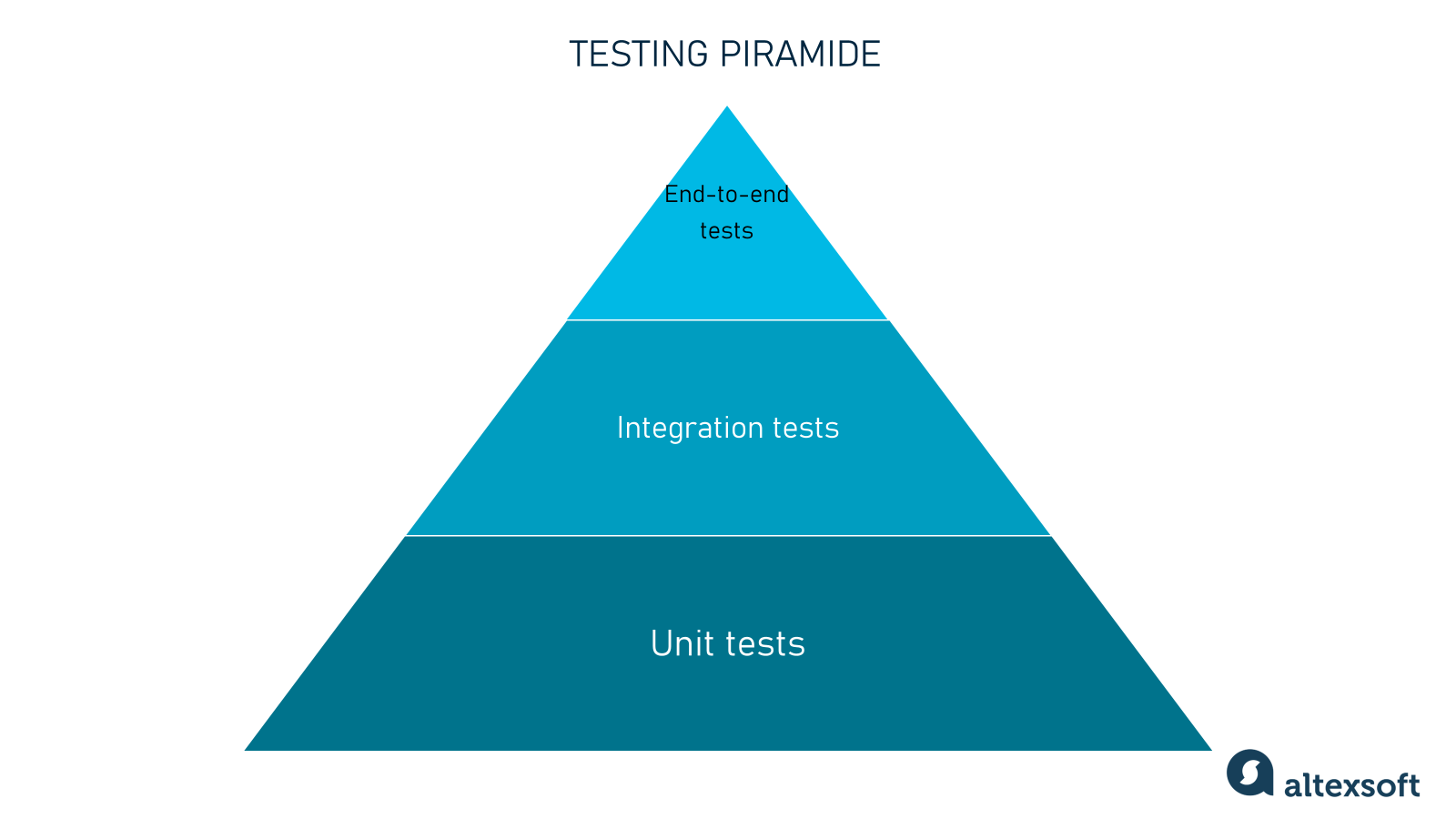Software projects often struggle with requirements drift, stakeholder misunderstandings, slow feedback loops, and brittle test suites. In a complex system with frequent releases, small ambiguities translate into costly defects, misalignment, and delays. Behavior-driven development (BDD) offers a way to address many of these challenges. It’s a collaborative approach that links business goals, user behavior, and technical implementation.
In this post, we’ll explain how BDD works in test automation and how it helps teams deliver more reliable, aligned, and maintainable software. We’ll also discuss how we introduced BDD into one of our projects, its strengths and trade-offs, and what we learned along the way.
What is BDD framework, and how does it work in test automation?
Behavior-driven development is a development and testing methodology that combines requirement specifications, test automation, and stakeholder collaboration. It centers on defining the system's expected behaviors using examples in plain, domain-specific language.
BDD builds on ideas from Test-Driven Development (TDD). In TDD, the team starts by writing tests that the future code must pass—only then do they proceed with the code itself. This may sound a bit counterintuitive, but it’s actually similar to manufacturing parts on a production line: Each component is checked against a finished template to ensure it meets the required standards.
Like TDD, BDD also involves writing tests before coding the product. However, it takes a broader approach, bringing together several aspects of the development process.
The AltexSoft QA team used the BDD approach while implementing automated testing for a complex quick-service restaurant (QSR) system.
The client, a hospitality and specialty communications industry leader, supplies and supports drive-thru technologies, among other things. Our engineers aimed to automate critical functionality and regression testing, reducing manual effort and improving release cycle efficiency. The main challenge was performing integration testing between different types of devices (hardware) and the web application that manages accounts, store and device data.
Using our project as an example, let’s examine the key components of BDD and see how they work in practice.
BDD feature files: human-readable format for user stories
Like any development approach, BDD bases future development on user stories—real-world examples of how the system should behave from the user's perspective. What makes BDD unique is that user stories are formatted as feature files—documents written in a human-readable language so non-technical people (product owners, business analysts, manual QA, etc.) can participate.

What is Gherkin in test automation
This format is often implemented with the syntax of plain-text programming language Gherkin, which follows the Given-When-Then structure, where
- given defines the precondition,
- when describes the action or change in the system, and
- then specifies the expected result of that action.
This language bridges the gap between business and tech.“BDD allows anyone on the team—not just engineers—to read and understand what’s being tested. The feature files become a shared space where product managers, developers, and testers speak the same language,” explains Violetta Yurieva, QA Automation Engineer at AltexSoft. “In our case, manual QA engineers on the client’s side drafted feature files, describing user stories like data flow validation, or hardware management.”
A single feature file (e.g., order processing) may contain one user story but multiple scenarios—for instance, one positive, like “Successful order placement and payment,” and several negative, such as “Menu item becomes unavailable after selection” or “Payment failure due to insufficient funds.”
Here is a simplified, descriptive feature file for the data validation functionality of a hypothetical QSR system, as an example:

An illustrative example of a feature file.
Best BDD practices include making scenarios atomic: Each one should validate a single behavior or outcome.
What makes the future file format powerful is that each line in a file is connected to the underlying automation code. This integration turns the plain-text scenarios into executable specifications—living documentation that describes the system’s behavior and verifies it automatically.
Under the hood, it’s still code doing the work. BDD just adds a human-readable layer—feature files that the whole team can contribute to—and step definitions that automation engineers turn into executable tests
Gathering requirements together: Three Amigos
In the standard BDD flow, user stories are gathered by the team, including a product owner, testers, and developers (the so-called “Three Amigos”). The main goal of the Three Amigos is to prevent misunderstandings early, before code is written.
When these three roles discuss a user story or feature together, they can clarify:
- exactly what the feature should do,
- what edge cases might occur, and
- how the feature can be tested and validated.
This shared discussion helps the team write better test scenarios because everyone agrees on the same behavior from the start.
But that’s the theory. In practice, sustaining that level of collaboration proved harder than it looked to sustain.
“The idea of the Three Amigos is great, but in reality, teams rarely have the time for joint scenario-writing sessions. Our project involved refinement and sprint planning meetings, during which collaboration took place between the product owner, developers, and QA,” says Violetta.
Anyway, BDD still delivered tangible communication benefits. Even without constant workshops, writing tests in Gherkin made requirements clearer and test cases more business-aligned, which was especially valuable in an integration-heavy project involving multiple devices and a cloud portal.
Step definitions: bridging scenario to code
Once the scenarios are defined, they can be automated using BDD frameworks such as Cucumber, SpecFlow, or Behave. These tools bridge each Gherkin step (for instance, “Given the user is on the login page”) to a function called a step definition. The latter is the code that tells the system how to perform each step described in the feature file.
Step definitions are written in a programming language supported by your chosen framework (for instance, Java or Kotlin in Cucumber-JVM, JavaScript/TypeScript in Cucumber.js, etc). During the project, we used Cucumber and Java. “Cucumber was the client’s choice, and it worked perfectly for feature files and step definitions written in the “Given–When–Then” format”, says Violetta.
The step definitions rely on libraries like Selenium, REST-assured, Playwright, etc., to actually perform actions and checks. We used Selenium WebDriver, along with the Atlas framework (a Selenium wrapper).
Here is a simplified, descriptive example of some step definitions written in Java for the above data validation case scenario:

An illustrative example of step definitions
Good BDD practice is to reuse step definitions to keep tests consistent and maintainable, so that a single step definition (for example, opening a login page) can be shared throughout multiple feature files.
Integration with CI/CD: continuous feedback loop
Testing integration with CI/CD creates a continuous feedback loop, providing developers with immediate alerts when a feature's behavior deviates from the specification.
So, after the feature is implemented, both the source code and BDD feature files are stored in the same version control system (e.g., GitHub, GitLab, Bitbucket). CI/CD tools like Jenkins, GitLab CI, GitHub Actions, or Azure DevOps trigger a pipeline whenever code is updated and also run tests regularly (usually bi-weekly) to check the system's behavior.
In our project, the AltexSoft QA team built CI/CD integration using Jenkins. This setup allowed regression tests to run automatically in User Acceptance Testing (UAT) environments and specific test suites to execute on live systems after deployment.


Why use BDD: Advantages and limitations
Like any methodology, BDD has both strengths and trade-offs. Below we’ll look at the key benefits it offers—and the limitations to be aware of when deciding whether it’s right for your project.
What makes BDD worth adopting
BDD has several advantages over more traditional or less structured approaches. Here are the main ones.
Improved collaboration and shared understanding. Everyone agrees on the “what” before jumping into the “how to build it.”
No surplus code writing. Once the scenarios are written, developers implement only the code required to pass those tests. BDD helps avoid building features nobody asked for. It also maintains alignment with business goals, scope, and priorities. This disciplined approach saves developers time and keeps the codebase lean and maintainable, preventing unnecessary complexity.
Early defect detection. Because behavior scenarios are defined early in the product development process, edge cases or misunderstandings can be discovered even before coding, lowering the cost of defect fixes.
Automated tests aligned with business behavior. The system is tested regularly against what matters to the business, not just technical units or components.
Faster feedback loops and better risk reduction. When BDD scenarios are included in the CI/CD pipeline, each change can be validated against other behaviors. Failures signal mismatches in business expectations early so that teams can respond quickly. This accelerates releases with more confidence.
Easy reporting. Our experience has shown that using BDD and Cucumber facilitates test reporting. “Since steps are already described in human-readable language in feature files, there was no need to write extra descriptions—the reports automatically reflected those steps. Reporting visualizes the results of automated tests, and in the case of Cucumber, the structure directly matches the feature file,” says Violetta Yurieva.
The AltexSoft team leveraged BrowserStack, a cloud-based testing platform for mobile-web validation, and Allure Reports, a test reporting framework that generates visual, interactive reports from automated test results. Each BDD scenario doubled as a reporting unit: step descriptions written in plain English appeared directly in Allure, creating readable reports for engineers and business stakeholders.
Practical constraints of BDD
Apart from advantages, BDD also introduced some technical hurdles.
For instance, Cucumber’s hooks (pre- and post-conditions for the tests, which can be used, in particular, to set up or clean up test data) and the ways they can be applied were more limited than in traditional frameworks like TestNG. “In other frameworks, you can configure @AfterTest for specific tests or test sets, but in Cucumber, the @After hook is applied to all scenarios by default,” explains Violetta. “As a result, in some cases the team had to add cleanup steps at the end of scenarios.”
Another challenge was passing data between steps—for example, creating an entity in one step and manipulating it in another. “We solved that using Cucumber PicoContainer, a library that provides a test and scenario context, allowing us to set and get shared data between steps. That worked really well”, continues Violetta.
Tangible results and lessons learned
In our project, BDD automation covered 68 percent of the regression suite, reducing manual testing effort and speeding up biweekly release validation. Automated tests running in the UAT environment caught bugs earlier in the cycle, preventing costly late-stage defects.
Beyond technical gains, the BDD approach improved collaboration and transparency.
- Manual testers could contribute feature files, which was important for the client and their manual QA team.
- Product owners could review and understand test cases.
- Automation engineers could maintain a clear link between code and business behavior.
The combination of readable tests, reusable components, and CI/CD integration made it easier to keep the suite up to date.
As for the lessons learned, the project revealed both strengths and limitations of BDD in practice. Here are some of them.
The BDD approach is best suited for end-to-end tests. BDD worked perfectly for functional and acceptance testing, but added unnecessary complexity for lower levels (like integration tests).

Testing piramide
If you look at the testing pyramid, there are unit tests written by developers for individual functions, integration tests for components, UI tests, and, at the top, acceptance or functional tests. End-to-end tests simulate the full user flow: logging in, performing actions, and verifying outcomes. Gerkin scenarios work best for end-to-end tests, while adding unnecessary complexity if used for lower-level testing
Atomic tests allow parallel execution. Best BDD practices emphasize writing atomic scenarios—each should verify one distinct behavior or expected outcome. It requires wise test data management.
Atomic tests enable parallel execution, in contrast with interdependent or monolithic tests that rely on shared data or execution order. When each test is isolated and self-contained, multiple tests can run simultaneously across different environments or browsers without interfering with one another. This not only speeds up execution time but also improves reliability, since the outcome of one test doesn’t affect the others. But they also require careful planning of test data and configuration.
Maintenance requires discipline. Keeping scenarios aligned with product changes demanded ongoing attention.
Balancing manual and automated tests is crucial. While automation covered a significant portion of the regression suite, manual testing remained essential for exploratory testing.
Automation + collaboration = real value. The greatest benefit wasn’t technical but cultural. Teams became more deliberate in defining “done” and “tested."
Ultimately, the BDD framework became a foundation for faster, more transparent testing. It bridged communication gaps and turned automated tests into living documentation for engineers and everyone involved in the product lifecycle.

Olga is a tech journalist at AltexSoft, specializing in travel technologies. With over 25 years of experience in journalism, she began her career writing travel articles for glossy magazines before advancing to editor-in-chief of a specialized media outlet focused on science and travel. Her diverse background also includes roles as a QA specialist and tech writer.
Want to write an article for our blog? Read our requirements and guidelines to become a contributor.

